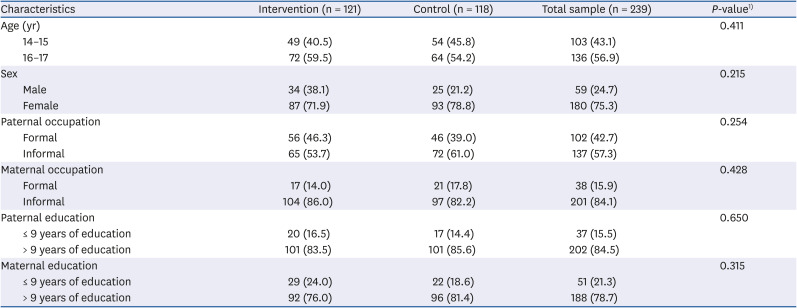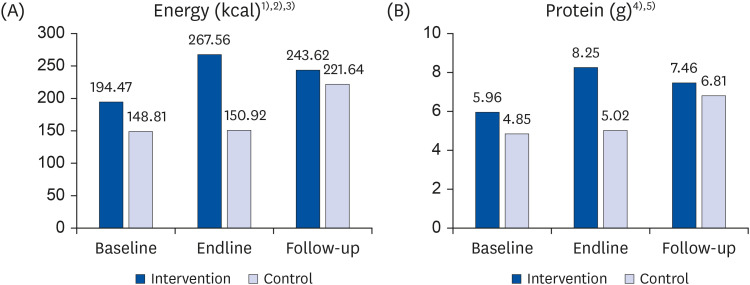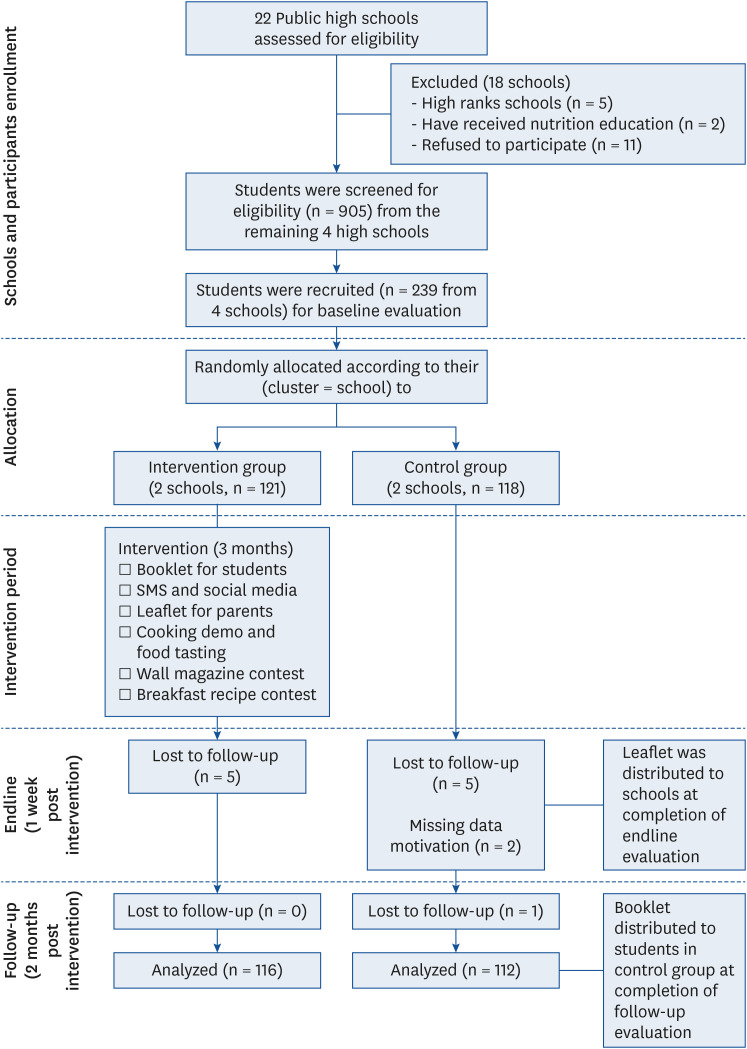1. Moreno LA, Gottrand F, Huybrechts I, Ruiz JR, González-Gross M, DeHenauw S. HELENA Study Group. Nutrition and lifestyle in European adolescents: the HELENA (Healthy Lifestyle in Europe by Nutrition in Adolescence) study. Adv Nutr. 2014; 5:615S–623S. PMID:
25469407.

2. Bi H, Gan Y, Yang C, Chen Y, Tong X, Lu Z. Breakfast skipping and the risk of type 2 diabetes: a meta-analysis of observational studies. Public Health Nutr. 2015; 18:3013–3019. PMID:
25686619.

3. Adolphus K, Lawton CL, Dye L. The effects of breakfast on behavior and academic performance in children and adolescents. Front Hum Neurosci. 2013; 7:425. PMID:
23964220.

4. Edefonti V, Rosato V, Parpinel M, Nebbia G, Fiorica L, Fossali E, Ferraroni M, Decarli A, Agostoni C. The effect of breakfast composition and energy contribution on cognitive and academic performance: a systematic review. Am J Clin Nutr. 2014; 100:626–656. PMID:
24808492.

5. Doku D, Koivusilta L, Raisamo S, Rimpelä A. Socio-economic differences in adolescents' breakfast eating, fruit and vegetable consumption and physical activity in Ghana. Public Health Nutr. 2013; 16:864–872. PMID:
22030213.

6. Sivaramakrishnan M, Kamath V. A typical working-day breakfast among children, adolescents and adults belonging to the middle and upper socio-economic classes in Mumbai, India - challenges and implications for dietary change. Public Health Nutr. 2012; 15:2040–2046. PMID:
22647430.

7. Hardinsyah. Problems and Importance of Breakfast in Children. Santa Fe: Breakfast Symposium;2012.
8. Irdiani W, Nindya TS. Correlation between the habit of eating breakfast, nutrient intake and nutritional status of female students in SMAN 3 Surabaya. Amerta Nutr. 2017; 1:227–235.
9. Sari AFI, Briawan D, Dwiriani CM. Breakfast habit and its quality of schoolgirls in Bogor District. Jurnal Gizi dan Pangan. 2012; 7:97–102.
10. Amrin SH. Relationship of breakfast habit and supplement consumption with hemoglobin status among adolescent girls in 10th state senior high school in Makassar [dissertation]. Makassar: Hasanuddin University;2014.
11. Thasim S. Effect of nutrition education: the use of booklet and social media (Line) to motivation, self-efficacy, and breakfast behaviour among adolescents in 21th and 16th senior high school Makassar [master's thesis]. Makassar: Hasanuddin University;2016.
12. Ministry of Health (ID). Basic Health Survey. Jakarta: Ministry of Health;2010.
13. Hardinsyah , Aries M. Type of food for breakfast and its roles in daily nutrient intakes of school age children 6–12 years in Indonesia. Jurnal Gizi dan Pangan. 2012; 7:89–96.
14. Harahap H, Widodo Y, Sandjaja , Khouw I, Deurenberg P. Quantity and quality of breakfast of children aged 2.0 to 12.9 years in Indonesia. J Indones Nutr Assoc. 2019; 42:31–42.
15. Susanto F. Breakfast nutrient analysis among school age children in Jakarta area, Indonesia. Asian J Agric Food Sci. 2015; 03:455–460.
16. Stang JS, Stotmeister B. Nutrition in adolescence. Temple N, Wilson T, Bray G, editors. Nutrition Guide for Physicians and Related Healthcare Professionals 2017. Cham: Humana Press;2017. p. 29–39.
17. Bartfeld JS, Ahn HM. The school breakfast program strengthens household food security among low-income households with elementary school children. J Nutr. 2011; 141:470–475. PMID:
21228262.

18. Canterbury District Health Board. School Breakfast Programmes for Adolescents: Literature Review. Christchurch: Canterbury District Health Board;2014.
19. Sekiyama M, Kawakami T, Nurdiani R, Roosita K, Rimbawan R, Murayama N, Ishid H, Nozue M. School feeding programs in Indonesia. Jpn J Nutr Diet. 2018; 76:86–97.

20. Ministry of Health (ID). Balanced Nutrition Guidelines. Jakarta: Directorate General of Nutrition and Maternal and Child Health Ministry of Health, Indonesia;2014.
21. Usfar AA, Fahmida U. Do Indonesians follow its dietary guidelines?: evidence related to food consumption, healthy lifestyle, and nutritional status within the period 2000–2010. Asia Pac J Clin Nutr. 2011; 20:484–494. PMID:
21859671.
22. Savage A, Februhartanty J, Worsley A. Adolescent women as a key target population for community nutrition education programs in Indonesia. Asia Pac J Clin Nutr. 2017; 26:484–493. PMID:
28429915.
23. Hoelscher DM, Evans A, Parcel GS, Kelder SH. Designing effective nutrition interventions for adolescents. J Am Diet Assoc. 2002; 102:S52–63. PMID:
11902389.

24. Rachman PH, Mauludyani AVR, Ekawidyani KR, Februhartanty J. Barriers of implementing a nutrition education program for adolescents in rural Indonesian schools. Malays J Med Health Sci. 2020; 16:34–45.
25. Februhartanty J. Nutrition education: it has never been an easy case for Indonesia. Food Nutr Bull. 2005; 26:S267–74. PMID:
16075577.

26. Tappe MK, Allensworth DD, Grizzell J. Promoting health in schools and universities. Fertman CI, Allensworth DD, editors. Health Promotion Programs: from Theory to Practice. San Francisco (CA): Jossey Bass;2010. p. 314–338.
27. Wang D, Stewart D. The implementation and effectiveness of school-based nutrition promotion programmes using a health-promoting schools approach: a systematic review. Public Health Nutr. 2013; 16:1082–1100. PMID:
22850118.

28. Contento IR. Nutrition education: linking research, theory, and practice. Asia Pac J Clin Nutr. 2008; 17(Suppl 1):176–179. PMID:
18296331.
29. Pérez-Rodrigo C, Aranceta J. School-based nutrition education: lessons learned and new perspectives. Public Health Nutr. 2001; 4:131–139. PMID:
11255503.

30. Meiklejohn S, Ryan L, Palermo C. A systematic review of the impact of multi-strategy nutrition education programs on health and nutrition of adolescents. J Nutr Educ Behav. 2016; 48:631–646.e1. PMID:
27720105.

31. Millar L, Kremer P, de Silva-Sanigorski A, McCabe MP, Mavoa H, Moodie M, Utter J, Bell C, Malakellis M, Mathews L, Roberts G, Robertson N, Swinburn BA. Reduction in overweight and obesity from a 3-year community-based intervention in Australia: the ‘It's Your Move!’ project. Obes Rev. 2011; 12(Suppl 2):20–28. PMID:
22008556.

32. Kebaili R, Harrabi I, Maatoug J, Ghammam R, Slim S, Ghannem H. School-based intervention to promote healthy nutrition in Sousse, Tunisia. Int J Adolesc Med Health. 2014; 26:253–258. PMID:
24096439.

33. Dehdari T, Rahimi T, Aryaeian N, Gohari MR. Effect of nutrition education intervention based on Pender's Health Promotion Model in improving the frequency and nutrient intake of breakfast consumption among female Iranian students. Public Health Nutr. 2014; 17:657–666. PMID:
23360695.

34. Elseifi OS, Abdelrahman DM, Mortada EM. Effect of a nutritional education intervention on breakfast consumption among preparatory school students in Egypt. Int J Public Health. 2020; 65:893–903. PMID:
32725393.

35. Fjeldsoe BS, Marshall AL, Miller YD. Behavior change interventions delivered by mobile telephone short-message service. Am J Prev Med. 2009; 36:165–173. PMID:
19135907.

36. Shahril MR, Wan Dali WP, Lua PL. A 10-week multimodal nutrition education intervention improves dietary intake among university students: cluster randomised controlled trial. J Nutr Metab. 2013; 2013:658642. PMID:
24069535.

37. Vander Wyst KB, Vercelli ME, O'Brien KO, Cooper EM, Pressman EK, Whisner CM. A social media intervention to improve nutrition knowledge and behaviors of low income, pregnant adolescents and adult women. PLoS One. 2019; 14:e0223120. PMID:
31647852.

38. Chau MM, Burgermaster M, Mamykina L. The use of social media in nutrition interventions for adolescents and young adults-a systematic review. Int J Med Inform. 2018; 120:77–91. PMID:
30409348.

39. Indriasari R, Thasim S, Nyorong M. Effect of nutrition education using booklet and mobile phone communications on changes of motivation, self-efficacy, and breakfast practice in Indonesian adolescents. Malays J Nutr. 2017; 23.
40. Contento IR. Nutrition Education: Linking Research, Theory and Practice. London: Jones and Barlett;2011. p. 68–69.
41. Prochaska JO, Velicer WF. The transtheoretical model of health behavior change. Am J Health Promot. 1997; 12:38–48. PMID:
10170434.

42. Mullan B, Wong C, Kothe E, O'Moore K, Pickles K, Sainsbury K. An examination of the demographic predictors of adolescent breakfast consumption, content, and context. BMC Public Health. 2014; 14:264. PMID:
24645936.

43. Wang D, Stewart D, Chang C, Shi Y. Effect of a school-based nutrition education program on adolescents' nutrition-related knowledge, attitudes and behaviour in rural areas of China. Environ Health Prev Med. 2015; 20:271–278. PMID:
25773683.

44. Au LE, Whaley S, Rosen NJ, Meza M, Ritchie LD. Online and in-person nutrition education improves breakfast knowledge, attitudes, and behaviors: a randomized trial of participants in the special supplemental nutrition program for women, infants, and children. J Acad Nutr Diet. 2016; 116:490–500. PMID:
26669795.

45. Bessems KM, van Assema P, Crutzen R, Paulussen TG, de Vries NK. Examining the relationship between completeness of teachers' implementation of the Krachtvoer healthy diet programme and changes in students' dietary intakes. Public Health Nutr. 2013; 16:1273–1280. PMID:
22894875.

46. Dzielska A, Mazur J, Nałęcz H, Oblacińska A, Fijałkowska A. Importance of self-efficacy in eating behavior and physical activity change of overweight and non-overweight adolescent girls participating in healthy me: a lifestyle intervention with mobile technology. Nutrients. 2020; 12:212.

47. Oddo VM, Roshita A, Rah JH. Potential interventions targeting adolescent nutrition in Indonesia: a literature review. Public Health Nutr. 2019; 22:15–27. PMID:
30348243.

48. Racey M, O'Brien C, Douglas S, Marquez O, Hendrie G, Newton G. Systematic review of school-based interventions to modify dietary behavior: does intervention intensity impact effectiveness? J Sch Health. 2016; 86:452–463. PMID:
27122145.

49. Bauer KW, Foster GD, Weeks HM, Polonsky HM, Davey A, Sherman S, Abel ML, Ruth KJ, Dale LC, Fisher JO. Breakfast in the classroom initiative and students' breakfast consumption behaviors: a group randomized trial. Am J Public Health. 2020; 110:540–546. PMID:
32078356.

50. Moore GF, Murphy S, Chaplin K, Lyons RA, Atkinson M, Moore L. Impacts of the primary school free breakfast initiative on socio-economic inequalities in breakfast consumption among 9–11-year-old schoolchildren in Wales. Public Health Nutr. 2014; 17:1280–1289. PMID:
24476560.

51. Ritchie LD, Rosen NJ, Fenton K, Au LE, Goldstein LH, Shimada T. School breakfast policy is associated with dietary intake of fourth- and fifth-grade students. J Acad Nutr Diet. 2016; 116:449–457. PMID:
26433452.

52. Jenkins KT, Benton D, Tapper K, Murphy S, Moore L. A cross-sectional observational study of the nutritional intake of UK primary school children from deprived and non-deprived backgrounds: implications for school breakfast schemes. Int J Behav Nutr Phys Act. 2015; 12:86. PMID:
26109287.








 PDF
PDF Citation
Citation Print
Print






 XML Download
XML Download